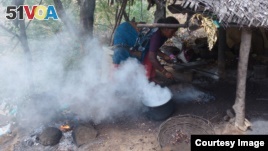09 December, 2014
Smokey cook fires are a leading cause of indoor air pollution - poor air quality inside buildings. Indoor air pollution kills more than four million people each year. The problem is bigger than malaria, tuberculosis or HIV, the virus that causes the disease AIDS.
Recently, people concerned about the issue met for two days of discussions in New York City. Their hope was to persuade private industry to build and sell better stoves.
Traditional open-fire cooking affects the health of both human beings and the world's environment. Collecting wood for cooking fires is one of the main causes of deforestation. And the gases and soot that come from the fires pollute the air. They also are partly responsible for rising temperatures.

Smoke rises from a cookstove in India, August 2014. (Global Alliance for Clean Cookstoves photo by Radha Muthiah)
At the meeting, former Secretary of State Hillary Clinton noted that almost three billion people use traditional stoves for heating and cooking. Because of their widespread use, she said, indoor air pollution is an international problem.
"But it also, if approached correctly, could be an economic opportunity. And that is the idea behind the alliance."
The Global Alliance for Clean Cookstoves supports companies that make and sell affordable, efficient and less-polluting cookers. The alliance also supports research into developing better stoves.
Ms. Clinton helped launch the group in 2010. At the meeting, the United States promised $200 million in financial support and research money. But organizers wanted to raise $500 million.
Radha Muthiah is the executive director of the alliance. She says four years after the group was launched, 20 million more households are using clean cookstoves.
"We've proven that this market-based approach works. Twenty million stoves later, we know that this is a recipe that can be scaled up."
Jim Jetter works as a researcher for the United States Environmental Protection Agency. He says it is not easy to build a low-cost device that people will use.
"It's a big technical challenge to make a cookstove that has low emissions of air pollutants, that is fuel efficient, and that is low-cost so that people can afford it -- and, most importantly, that it meets the user needs. If it doesn't meet the user's needs, then people do not use the stoves and, and then there are no benefits."
In 2012, improved stoves were tested at 15,000 homes in Orissa, India. Laboratory tests showed that the stoves lowered indoor air pollution. Harvard University economist Rema Hanna helped to write a report on the study.
"They slowly fell into disrepair, and households continued to use the traditional cooking stoves as well."
The study found that homes with the new stoves were no healthier than those with traditional ones, and they did not use less fuel.
Radha Muthiah says members of the Alliance know that it is not easy to solve the cookstove problem. She says the group is studying how people use them.
"There have been a lot of failures. Success takes a little bit longer, you know, to show, but we're, we're seeing that. And that, that definitely inspires me."
The Alliance says it wants 100 million more homes to have clean cookstoves by 2020. The group believes it will reach that goal early.
I'm Christopher Cruise.
VOA Science and Agriculture Correspondent Steve Baragona reported this story from Washington. Christopher Cruise wrote it for Learning English. He also read and produced the report. George Grow was the editor.
Here are some websites related to this story:
http://cookstovesfuturesummit.org/
http://www.epa.gov/airscience/air-cleancookstove.htm
http://papers.ssrn.com/sol3/papers.cfm?abstract_id=2039004
_______________________________________________________________
Words in This Story
smoky – adj. filled with smoke
tuberculosis – n. a disease that mainly affects the lungs
deforestation – n. the result of cutting down or burning all the trees in an area
soot – n. black particles that form when something (such as wood or coal) is burned
affordable – adj. to be something a person is able to pay for
market-based approach – n. a way of dealing with something based on economic forces; a way of doing or thinking about something
scaled-up – v. to increase something in size, amount or extent
disrepair – n. the state of needing to be repaired; bad condition
Now, it's your turn to use these Words in This Story. In the comments section, write a sentence using one of these words and we will provide feedback on your use of vocabulary and grammar.